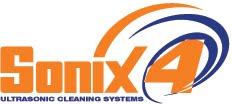It is important to consider certain aspects of the cleaning process in order to maximize cleaning efficiency and decrease the possibility of staff personnel exposure to pathogenic microorganisms.
Cleaning Solutions:
Cleaning solutions specifically formulated for ultrasonic cleaning and known to be compatible with the instruments to be cleaned are recommended to increase cleaning effectiveness and to protect the instruments from possible damage. Neutral or alkaline detergents are the most commonly used formulation that hospitals, surgical facilities, dental practices, and veterinarians use with ultrasonic cleaners.
Temperature:
Temperature of the liquid will affect both cavitation quality and the chemical cleaning action. Usually both can be improved by increasing operating temperature, however the cleaning solutions have a temperature point where they begin to break down, thus decreasing the cavitation and cleaning results. The optimum temperatures will vary according to the solutions physical properties, but as a rule of thumb most aqueous solutions cavitate best within the temperature range of 140-190 degrees Fahrenheit (60-88 degrees C), or as a general rule 2/3 the boiling point of the liquid. Beyond this optimum range cavitation will gradually decrease and at the boiling point cavitation will cease altogether. To avoid damage to the surgical instrument the temperature of the solution should not exceed the instrument's temperature parameters as recommended by the instrument manufacturer.
Since bacteria can proliferate in the ultrasonic cleaner's detergent solution its strongly recommended that the cleaning bath be changed often and regularly, and that a fresh volume of water be used for rinsing each new batch of instruments to minimize personnel exposure to potentially pathogenic microorganisms, to protect the instruments, and to prolong the life of the ultrasonic cleaner.
Accessories:
The benefits of ultrasonic cleaners can be maximized by using specially designed instrument baskets, trays, or cassettes. Accessories are crucial as they maximize exposure of the instruments to the direction of the ultrasonic waves, protect the instruments from damage abrading against each other during cleaning, and preventing the instruments from coming into contact with the bottom of the ultrasonic cleaner's tank which will cause damage to the unit. Accessories also provide protection for personnel minimizing the amount of instrument handling and potential injury.
Cleaning Cylce Time:
In addition to the type of cleaning solution used and the bath temperature, the cycle time needed to clean instruments will depend upon factors such as the load size - the number and arrangement of contaminated instruments, the degree of instrument contamination (e.g., lightly-soiled, heavily-soiled), as well as the frequency and power output efficiency of the ultrasonic cleaner.
In addition to increasing the productivity of reprocessing staff and minimizing the staff's exposure to contaminated instruments, ultrasonic cleaners have been shown to be substantially more effective and efficient than other methods for instrument cleaning whose results are often incomplete and unpredictable as they are unable to reach contamination in the hidden recesses that many of today's complicated surgical instruments possess.
Sonix IV Ultrasonic Cleaners have set the benchmark for cleaning and instrument reprocessing technology. For more than 38 years Sonix IV has been developing and manufacturing highly innovative ultrasonic cleaning products that address the need for versatility, flexibility, and efficiency in today’s environments.
Monday, July 26, 2010
Friday, July 9, 2010
How effective is ultrasonic cleaning?
Understanding that cavitation is the mechanism of cleaning in ultrasonic technology the effectiveness of ultrasonic cleaning can be controlled by several factors including how the acoustic signal is transferred into the cleaning tank, how efficiently that sound energy is converted to cavitation energy, and how that energy is transferred to the parts.
With today's increasingly complex surgical instruments, and the different materials used in their construction consideration of frequency and frequency modulation should be considered as a precaution to prevent part damage due to the varying components ability to absorb energy. The cavitation energy release and density from the collapsing bubbles formed in the cleaning solution is relative to the frequency and/or frequency sweep range of the ultrasonic transducers. Generally speaking low frequency ultrasonics will have superior performance for large particle removal while high frequency ultrasonics will yield better results for sub-micron particle removal, or precision cleaning.
When using ultrasonic cleaners to clean surgical instruments it's imperative that the equipment have sweep frequency circuitry that improves the performance of the cleaner and reduces the potential for damage to delicate parts.
Ultrasonic cleaning standardizes the cleaning process for removing dried serum, whole blood, microorganisms and other fine debris from inaccessible surfaces on contaminated instruments. Some reports suggest that ultrasonic cleaning, preceded by soaking in an enzymatic solution results in an even greater reduction in patient debris, and have demonstrated that as few as three minutes of ultrasonic exposure was sufficient to remove 99% of blood on contaminated instruments.
Reprocessing instructions for most surgical instruments recommend ultrasonic cleaning as an integral step in the preparation for sterilization. Some materials, such as quartz, silicon, and carbon steel may erode or become etched after prolonged exposure to ultrasonic cavitation, but can can be minimized, if not eliminated by reducing the ultrasonic cleaner's power and cleaning time. Review of each instrument's instruction manual from the manufacturer should determine whether ultrasonic cleaning is recommended.
Ultrasonic cleaning is usually a multi-step process that begins with a pre-soak to remove gross debris - this step is performed immediately after the instrument's use to prevent patient contamination from drying. Followed by immersion into the ultrasonic bath - this step is particularly important for removing fine debris that may not be removed using any other method of cleaning. The final steps are rinsing to remove detergent residue and drying. Some processes may involve the addition of a milk bath, or lubricating step to lubricate instruments to prevent corrosion prior to sterilization.
Most standard ultrasonic cleaners will feature a timer to adjust the cleaning time, and covers that reduce exposure of personnel to potentially harmful contaminants and aerosols during cleaning. They may also be equipped with temperature controls to increase the temperature of the detergent solution, and power intensity controls that permit adjustment of their power output (Watts), as well as instrument trays, holders and baskets.
Factors that can enhance or limit cleaning effectiveness:
Several factors can enhance or limit the cleaning effectiveness of an ultrasonic cleaner. None is as significant as the physical properties of the cleaning solution and that solutions ability to propagate the ultrasonic energy. The point at which cavitation begins is called the cavitation threshold and is reached when the energy applied is sufficient to drop the pressure within the liquid below its vapor pressure during rarefaction. The properties of the cleaning solution, which include its temperature, viscosity, density, vapor pressure, and surface tension cause the threshold value to vary such that changes in any one of these properties is likely to affect cleaning effectiveness.
With today's increasingly complex surgical instruments, and the different materials used in their construction consideration of frequency and frequency modulation should be considered as a precaution to prevent part damage due to the varying components ability to absorb energy. The cavitation energy release and density from the collapsing bubbles formed in the cleaning solution is relative to the frequency and/or frequency sweep range of the ultrasonic transducers. Generally speaking low frequency ultrasonics will have superior performance for large particle removal while high frequency ultrasonics will yield better results for sub-micron particle removal, or precision cleaning.
When using ultrasonic cleaners to clean surgical instruments it's imperative that the equipment have sweep frequency circuitry that improves the performance of the cleaner and reduces the potential for damage to delicate parts.
Ultrasonic cleaning standardizes the cleaning process for removing dried serum, whole blood, microorganisms and other fine debris from inaccessible surfaces on contaminated instruments. Some reports suggest that ultrasonic cleaning, preceded by soaking in an enzymatic solution results in an even greater reduction in patient debris, and have demonstrated that as few as three minutes of ultrasonic exposure was sufficient to remove 99% of blood on contaminated instruments.
Reprocessing instructions for most surgical instruments recommend ultrasonic cleaning as an integral step in the preparation for sterilization. Some materials, such as quartz, silicon, and carbon steel may erode or become etched after prolonged exposure to ultrasonic cavitation, but can can be minimized, if not eliminated by reducing the ultrasonic cleaner's power and cleaning time. Review of each instrument's instruction manual from the manufacturer should determine whether ultrasonic cleaning is recommended.
Ultrasonic cleaning is usually a multi-step process that begins with a pre-soak to remove gross debris - this step is performed immediately after the instrument's use to prevent patient contamination from drying. Followed by immersion into the ultrasonic bath - this step is particularly important for removing fine debris that may not be removed using any other method of cleaning. The final steps are rinsing to remove detergent residue and drying. Some processes may involve the addition of a milk bath, or lubricating step to lubricate instruments to prevent corrosion prior to sterilization.
Most standard ultrasonic cleaners will feature a timer to adjust the cleaning time, and covers that reduce exposure of personnel to potentially harmful contaminants and aerosols during cleaning. They may also be equipped with temperature controls to increase the temperature of the detergent solution, and power intensity controls that permit adjustment of their power output (Watts), as well as instrument trays, holders and baskets.
Factors that can enhance or limit cleaning effectiveness:
Several factors can enhance or limit the cleaning effectiveness of an ultrasonic cleaner. None is as significant as the physical properties of the cleaning solution and that solutions ability to propagate the ultrasonic energy. The point at which cavitation begins is called the cavitation threshold and is reached when the energy applied is sufficient to drop the pressure within the liquid below its vapor pressure during rarefaction. The properties of the cleaning solution, which include its temperature, viscosity, density, vapor pressure, and surface tension cause the threshold value to vary such that changes in any one of these properties is likely to affect cleaning effectiveness.
Subscribe to:
Comments (Atom)

